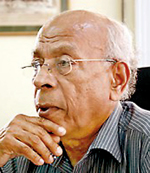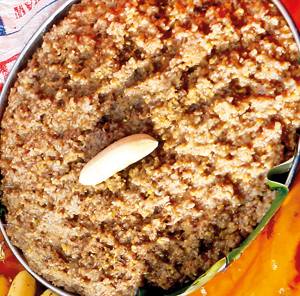Colonial flavours on our traditional Avurudu table

Prof. K.D. Paranavitana
Come Avurudu, the aroma of kevum, kokis and laddu permeate the air. Village veterans pride themselves on their best ‘konde’ (of the kevuma) and mothers boast of the crisp bite of the kokis and murukku which keep the children at home and the guests asking for more. And the cuckoo bird calls upon Sinhala and Tamil brethren to come together in a spirit of brotherhood at a common auspicious time to partake of kiribath and sakkara pongal.
John Davy in his work, ‘Account of the Interior of Ceylon and of its inhabitants with Travels in that Island’ documents that among the four great festivals which were celebrated by the locals, ‘awooroodu mangal le’ or the feast of the new year was significant. The others are namely the Kandy perahera, Kartiemangalle or the feast of the fortune hour and aluth sahal mangalyaya. Davy in his description of the new year festivities of the Kandyan kingdom notes: “before the approach of the new year, the king’s physician and astrologers had certain duties to perform. The former had to superintend the preparation of a thousand small pots of juices of wild medicinal plants at the Nata Dewale, from whence carefully covered and sealed, they were to be sent to the palace and distributed with much ceremony to other temples.’

Kokis: A modification of the Dutch koekjes meaning cookies and konde kevum: Portuguese connections. Pix by M.A. Pushpa Kumara
Davy goes on to note that one of the duties of the astrologers was to ‘lay down the precise minute’ of the commencement of the new year, in the form of a nekatwattoru. “At the time appointed for the commencement of the new year, which amongst the Singalese is always April, the king sat on his throne in state, surrounded by his chiefs and the event was announced to the public by the discharge of jingles,” records the author. Robert Knox too in his famous An Historical Relation of the Island Ceylon notes that the new year was celebrated in the capital with royal patronage.
While the British colonists described the new year festivities in their diaries and journals, it is interesting to note that it was their predecessors – the Portuguese and the Dutch who wielded their influence mostly on the new year delicacies, largely those found on the Sinhala new year table, particularly in the southern and western coastal areas. The Dutch who held the forts of Calicut, when they arrived here brought with them their recipes which, according to the Dutch authority, Prof. K.D. Paranavitana, underwent modifications. “It is believed that the Dutch

Prof. S. Pathmanathan
brought with them some of their slaves and domestic servants who had to substitute certain ingredients when they arrived here, hence we find kokis which is a modification of the Dutch koekjes meaning, cookies.”
Another mouth-watering delicacy, bibikkan which is getting scarce on the table is believed to be a Portuguese legacy. “There is a Portuguese layer cake known as bibica/bebinca. Sebastião Rodolfo Dalgado in his work- Glossario Luso-Asiatico (1921) refers to an Indo-Portuguese sweet called bebica with two variables bibica and bebinca which is prepared with rice flour and jaggery, baked in the oven for nearly an hour. It is possible that this sweet too may have migrated here via the Portuguese settlements in the Western seaboard of India,” says Prof. Paranavitana. Although many use bibikkan and pol cake synonymously today, it is not so, says Prof. Paranavitana, adding that bibikkan in its original flavour differs from pol or coconut cake.
A delicacy which the Southerners take pride in, the historian remembers bibikkan from his childhood days in Baddegama.“The bakkare or the baker in the village was specialized in supplying bibikkan to meet the demand of the villagers. The sago orsav which used to be an ingredient in it is virtually non-existent today.”

Pongal rice: Traditional Hindu new year delicacies are largely uninfluenced by the colonial heritage
Konda kevum anyone? The skill of spinning a perfect konde which some old grandmas boast of, is a gift from the Portuguese, says Prof. Paranavitana. “Konde is the word used to denote the hair style of Indo-European women in the former Dutch East Indies who placed their hair on the back of the head in the form of a bun. This word has even been absorbed into the modern Dutch vocabulary kondee. When the peti kevum got a konde part of it combined with kevum generating a new form of delicacy added to the newyear festivities.
“The native kevum varieties are athirasa, mung kevum and naran kevum, he says. “There is reference to these native varieties in ancient Sinhala literature such as Ummagga Jathakaya in which kevum is referred to as Puu.”
Aluva, another delicacy and kalu dodol are also believed to have indirectly reached us though other Portuguese settlements in the Indonesian Archipelago.
The Tamil new year table remains a modest one in comparison, the dishes largely influenced by the culture of offerings made to the Hindu deities, says historian and Chancellor of the Jaffna University, Prof. S. Pathmanathan. “The traditional delicacies of the Hindu new year table remain largely uninfluenced by the colonial heritage and Kiribath or Pongal rice remain common to both the Sinhalese and the Tamil brethren, although variations are prevalent.” Interestingly milk rice common to both ethnicities is believed to be the oldest ‘auspicious food’ gracing the table, untouched by colonial heritage. Sakkarai pongal or sweet pongal is another variety of milk rice flavoured with jaggery, cashew and plums.
The Hindu equivalent to kevum which is mothakam is made out of a mixture of coconut, jaggery and green peas. As Prof. Pathmanathan explains, mothakam and milk rice are the two new year dishes offered to the deities on the new year’s day, accompanied by an assortment of fruits, largely banana, mango and lemon. “To serve the guests and to share among friends and neighbours, paniyaram and murukku are prepared,” explains Prof. Pathmanathan who goes on to note that dishes such as laddu and kesari are new entries to the traditional new year table.


